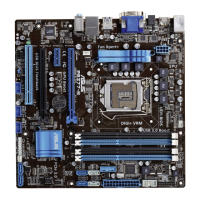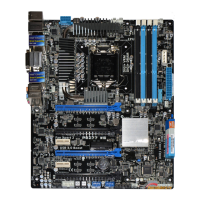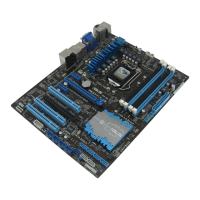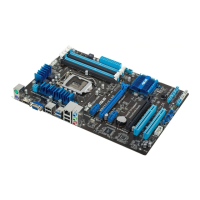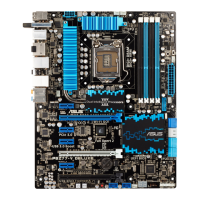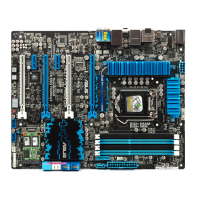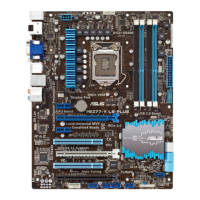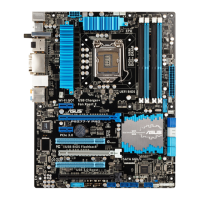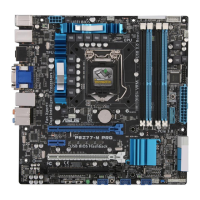
Do you have a question about the Asus P8Z77-M PRO and is the answer not in the manual?
| ECC | No |
|---|---|
| Non-ECC | Yes |
| Memory voltage | 1.5 V |
| Memory channels | Dual-channel |
| Memory slots type | DIMM |
| Number of memory slots | 4 |
| Supported memory types | DDR3-SDRAM |
| Maximum internal memory | 32 GB |
| Supported memory clock speeds | 1066, 1333, 1600, 1800, 1866, 2000, 2133, 2200, 2400 MHz |
| Supported memory module capacities | 16GB, 1GB, 2GB, 4GB, 8GB |
| System bus rate | 5 GT/s |
| Processor socket | LGA 1155 (Socket H2) |
| Processor manufacturer | Intel |
| Compatible processor series | Intel Core i3, Intel Core i5, Intel Core i7 |
| Maximum number of SMP processors | 1 |
| USB 2.0 connectors | 3 |
| Number of SATA III connectors | 2 |
| Number of Parallel ATA connectors | 0 |
| Headphone outputs | 6 |
| USB 2.0 ports quantity | USB 2.0 ports have a data transmission speed of 480 Mbps, and are backwards compatible with USB 1.1 ports. You can connect all kinds of peripheral devices to them. |
| Audio chip | Realtek ALC892 |
| Cooling type | Passive |
| Component for | PC |
| Power source type | ATX |
| Motherboard chipset | Intel Z77 |
| PC health monitoring | CPU, FAN, Temperature |
| Audio output channels | 7.1 channels |
| Motherboard form factor | micro ATX |
| RAID levels | 0, 1, 5, 10 |
| Supported storage drive interfaces | SATA II, SATA III |
| Cables included | SATA |
| Graphics card | HD Graphics |
| OpenGL version | 3.2 |
| DirectX version | 11 |
| Maximum resolution | 2048 x 1536 pixels |
| Maximum graphics card memory | 1696 MB |
| Parallel processing technology support | 2-Way CrossFireX, 2-Way SLI, 3-Way CrossFireX, LucidLogix Virtu, Quad-GPU CrossFireX, Quad-GPU SLI |
| PCI Express slots version | 2.0, 3.0 |
| PCI Express configurations | 1x4, 1x16, 2x8 |
| Controller 2nd interface type | ASMedia ASM1061 |
| LAN controller | Realtek RTL8111F |
| Wi-Fi standards | Not supported |
| Networking features | Gigabit LAN |
| Ethernet interface type | Gigabit Ethernet |
| BIOS type | EFI AMI |
| ACPI version | 2.0a |
| BIOS memory size | 64 Mbit |
| Width | 244 mm |
|---|
Precautions to prevent electrical shock hazard.
Precautions for safe operation and handling of components.
Advanced overclocking controls.
Overview of major product features and technologies.
Advanced power and performance control features.
Unique ASUS software and hardware features.
Safety precautions before hardware installation.
Details on the CPU socket and installation.
Information about DIMM slots and memory installation.
Details on PCI Express slots and their configurations.
Connectors for ATX power supply.
Steps for assembling a PC system.
Step-by-step guide for CPU installation.
Guide for installing the CPU cooler.
Step-by-step guide for RAM installation.
Steps for mounting the motherboard in the chassis.
Guide for connecting the ATX power supply.
Guide for connecting SATA devices.
Connecting front panel connectors.
Guide for installing expansion cards.
Installing graphics cards into PCIe x16 slots.
Updating BIOS using USB Flashback.
Connecting peripherals to rear panel ports.
Initial power-on and POST procedures.
How to enter and navigate the BIOS setup.
Overview of the BIOS EZ Mode interface.
Introduction to the BIOS Advanced Mode interface.
BIOS security settings, including password management.
BIOS settings for overclocking.
Options for CPU overclocking configurations.
Setting for X.M.P. memory profiles.
Adjusting CPU and VGA frequencies.
Setting CPU core ratios for overclocking.
Controlling individual core ratios.
Setting ratio limit for one core.
Setting ratio limit for two cores.
Setting ratio limit for three cores.
Setting ratio limit for four cores.
Setting DRAM timing parameters.
Setting CAS Latency for DRAM timings.
Setting RAS to CAS delay for DRAM timings.
Setting RAS Precharge time for DRAM timings.
Setting RAS Active time for DRAM timings.
Setting DRAM command mode.
Advanced DRAM timing parameters.
Setting WRITE to READ delay for DRAM.
Setting CKE minimum pulse width.
Setting CAS Write Latency.
Setting DRAM RTL for Channel A.
Setting DRAM RTL for Channel B.
Setting DRAM IO-L for Channel A.
Setting DRAM IO-L for Channel B.
CPU power management settings.
Enabling/disabling Intel SpeedStep Technology.
Enabling/disabling CPU Turbo Mode.
Controlling CPU power phases.
Adjusting VRM duty control.
Configuring total power range for CPU.
Setting CPU voltage.
Setting a fixed CPU voltage.
Selecting sign for CPU offset voltage.
Setting CPU offset voltage.
Setting iGPU voltage.
Setting a fixed iGPU voltage.
Setting iGPU offset voltage.
Setting DRAM voltage.
Setting Platform Controller Hub voltage.
BIOS settings for advanced system configurations.
Displays CPU-related information detected by BIOS.
Enabling/disabling Intel Hyper-Threading Technology.
Selecting number of active CPU cores.
Managing and configuring CPU power.
Enabling/disabling Intel Rapid Start Technology.
BIOS settings for SATA devices.
Setting SATA controller mode (IDE, AHCI, RAID).
Selecting primary display device.
Choosing between iGPU and PCIe for primary display.
BIOS settings for USB features.
BIOS settings for onboard devices.
BIOS settings for power management.
Displays system temperatures, power status, and fan settings.
Setting CPU fan speed profiles.
Setting chassis fan speed profiles.
BIOS settings for system boot options.
Configuring UEFI and Legacy boot options.
Specifying boot device priority sequence.
Utility for updating BIOS via USB flash drive.
Storing and loading multiple BIOS settings.
Options to load defaults, save, or discard changes.
Loading default BIOS parameters.
Instructions for updating the motherboard BIOS.
Utility for managing and updating BIOS in Windows.
Utility for updating BIOS using USB flash drive.
Utility to restore BIOS if corrupted.
Utility for manual CPU overclocking and tuning.
Real-time CPU overclocking and voltage adjustments.
Manually adjusting the CPU ratio.
Automatic CPU overclocking modes.
Performing extreme overclocking for CPU and memory.
Adjusting VRM voltage and frequency for stability.
Utility to check and save BIOS versions.
Options for updating motherboard BIOS.
Configuring SATA mode to RAID in BIOS.
Steps to create a RAID volume using Intel RST.
Boosting system performance with SSD caching.
Configuring acceleration settings for SSD caching.
Enabling quick system wake-up from sleep.
Steps to create a partition for Rapid Start.
Activating or deactivating Intel Rapid Start.
Installing RAID driver during OS setup.
Guide for installing multiple ATI graphics cards.
Activating CrossFireX in Catalyst Control Center.
Guide for installing multiple NVIDIA graphics cards.
Activating SLI in NVIDIA Control Panel.
Configuring SLI settings in NVIDIA Control Panel.
Adjusting Virtu MVP features and applications.
